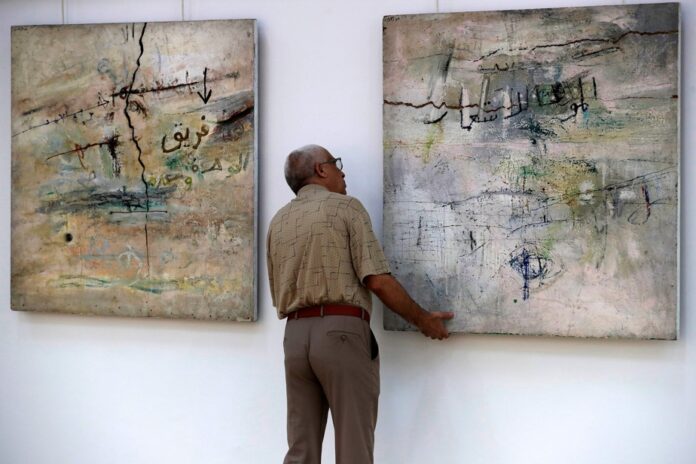(Baghdad) In a museum in Baghdad, Death to Colonialism is one of the few authentic canvases by Shakir Hassan al-Saïd having survived the chaos into which Iraq plunged in 2003 with the American invasion, and which boosted counterfeits and trafficking in works.
With its dark tones ranging from gray to blue, Death to Colonialism is one of the jewels of Iraqi art. Completed in the 1970s, it bears witness to the prosperous decades for Iraqi visual arts, during which Shakir Hassan al-Saïd maintained the Baghdad Modern Art Group with Jawad Salim.
“The works of Shakir Hassan al-Saïd have considerable importance for modern Iraqi art and indeed for all Middle Eastern art,” says writer Tamara Chalabi, director of the Ruya Foundation for Contemporary Art.
In the auction rooms, the paintings of the painter who died in 2004 sometimes reach 100,000 dollars. Anxious to protect his heritage, his family has listed his “complete archives” – some 3,000 works in total – and a catalog will be published soon, his son Mahmoud Shakir Hassan al-Saïd told AFP, seeing it as “immunity” against the false.
Because with the chaos installed in Iraq in 2003, regularly, “for greed, there are attempts to copy the works”, indignant Mr. Saïd.
“We happened to stop several sales of counterfeits,” confirms the 50-year-old, in contact with international auction houses and galleries.
“Recently we spotted a fake in Baghdad,” he adds. He contacted the gallery via social networks to demand the removal of the painting, without success, his interlocutor defending its authenticity.
First victims of trafficking and counterfeiters: the highly prized pioneers of modern Iraqi art. Their works from the 1940s, 1950s or 1960s disappeared with thousands of pieces stolen from museums and institutions looted in 2003.
In a restricted environment where everyone knows each other, the best way to avoid scams is to approach family or friends, even the artist himself if he is alive, or academics .
“Iraqi art, modern or contemporary, is one of the most important sources of artistic production in the Arab world,” said Sultan Sooud Al-Qassemi, a collector in the United Arab Emirates.
The prices charged rank Iraqi pieces in “the top 10 of the most expensive works” in the region, underlines the founder of the Barjeel Art Foundation, a Sharjah museum where more than a thousand works from the Arab world are exhibited.
“Today, some Iraqi works are selling for hundreds of thousands of dollars,” he told AFP. “Counterfeiters notice auction results. It’s an incentive to create more and more counterfeits.”
The authentication puzzle arises across the region – in Egypt, Lebanon and Syria in particular – but “the problem is particularly acute for Iraq, due to a pile of challenges: exile artists, the successive wars”, recognizes Sultan Al-Qassemi.
Today, the National Museum of Modern Art in Baghdad, affiliated with the Ministry of Culture, is still looking for stolen works. The data of a hundred pieces have been communicated to Interpol, indicates the former director of the institution, Ali al-Doulaïmi, recently retired.
However, it is impossible to know precisely what is missing, due to a hazardous listing. Under Saddam Hussein, the bureaucratic machine struggled to list works by hand in notebooks, a method with near-zero reliability.
“Before 2003 we had 8,000 works. Today there are about 2,000,” according to Doulaimi. After the American invasion, “we acquired new works and lost pieces were returned to us.” A drop of water in an ocean.
In 2017, Christie’s announced that it was withdrawing a 1968 painting by Faeq Hassan from auction in Dubai due to a “disagreement over ownership”. Ultimately, the canvas was never returned to Iraq.
At the time, an Iraqi MP explained that this painting was likely “on display at the Ministry of Defense officers’ club” before being “smuggled” out of the country.
In his elegant Akkad gallery in Baghdad, Hayder Hachem Naji laments an “increase in counterfeits which damages the reputation of Iraqi art”.
“Sometimes the counterfeiters use an old painting that they will repaint, the frame and the canvas will be old”, underlines the 54-year-old gallery owner.
Recently, he was offered to exhibit a painting attributed to the famous Cubist-influenced painter Hafidh al-Droubi. Its owner hoped to get $40,000 from it. He politely declined.
“Honestly, it was a very high quality counterfeit,” he admits.

